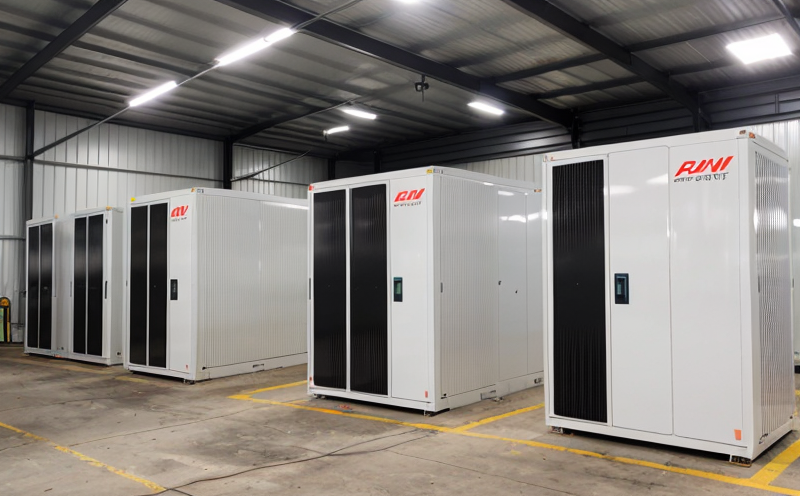ASTM E1742 Radiographic Testing of Battery Cells and Modules
The American Society for Testing and Materials (ASTM) E1742 standard provides a method for the radiographic examination of battery cells and modules. This non-destructive testing technique is critical in ensuring the structural integrity, homogeneity, and consistency of materials used in energy storage systems. Radiography allows for the visualization of internal defects or imperfections that could compromise the performance and safety of batteries.
ASTM E1742 radiographic testing involves the use of X-rays or gamma rays to penetrate the material being tested. The intensity of the radiation is reduced as it passes through denser materials, resulting in an image on a film or digital detector that reveals any internal flaws. This method is particularly useful for detecting voids, cracks, porosity, and other anomalies within battery cells and modules.
The testing process typically begins with the preparation of the specimen. The battery cell or module must be positioned in such a way that it exposes all critical areas to radiation. Proper positioning ensures that any defects will be visible on the resulting radiograph. Once the specimen is prepared, the radiographic examination proceeds using either X-rays or gamma rays.
The choice between X-rays and gamma rays depends on several factors including the thickness of the material being tested and the required resolution. For battery cells and modules, which are often thick and complex structures, high-energy gamma rays are generally preferred for their ability to penetrate deeper into the materials without excessive scattering.
After the examination, a radiograph is produced that serves as the basis for evaluation. The resulting image can reveal areas of concern within the battery cell or module. These areas may include voids, cracks, or other imperfections that could impact the performance and safety of the product. Once identified, these defects can be addressed through adjustments in manufacturing processes.
ASTM E1742 radiographic testing is a key component of quality assurance programs for energy storage systems. By identifying internal flaws early in the development process, manufacturers can ensure that their products meet stringent performance and safety standards. This non-destructive testing method allows for thorough inspection without damaging or altering the battery cells or modules.
Compliance with ASTM E1742 is essential for ensuring product quality and meeting regulatory requirements. This standard helps to establish a consistent approach to radiographic examination, which is critical for industries focused on energy storage solutions. The use of this method ensures that all manufacturers adhere to the same testing protocols, thereby promoting uniformity in product performance.
ASTM E1742 also plays a crucial role in research and development efforts within the energy sector. By providing standardized methods for radiographic examination, this standard enables researchers and engineers to compare results across different studies and facilities. This consistency is vital for advancing knowledge about battery cells and modules and improving overall product quality.
The ASTM E1742 standard specifies detailed procedures for preparing specimens, conducting the radiographic examination, and interpreting the resulting images. These specifications ensure that all tests are conducted in a consistent manner, which enhances reliability and repeatability of results. The use of this standard also facilitates communication between different stakeholders involved in energy storage projects, including manufacturers, regulatory bodies, and researchers.
ASTM E1742 radiographic testing is an indispensable tool for ensuring the quality and safety of battery cells and modules used in various applications such as electric vehicles, renewable energy systems, and grid-scale storage. By identifying internal flaws early in the manufacturing process, this method helps to prevent potential failures that could compromise performance or pose risks to users.
Benefits
- Promotes compliance with industry standards and regulations
- Ensures consistent quality across all manufactured products
- Achieves early detection of defects, reducing the risk of product failure
- Facilitates safer operation by identifying potential hazards within battery cells or modules
- Simplifies communication between different stakeholders involved in energy storage projects
- Supports research and development efforts aimed at improving battery performance and safety
- Enhances reliability and repeatability of testing results through standardized procedures
- Reduces costs associated with rework or product recalls due to internal defects
Eurolab Advantages
As a leading independent laboratory, Eurolab offers comprehensive services for ASTM E1742 radiographic testing of battery cells and modules. Our expertise in this field ensures that we provide accurate and reliable results every time.
- Experienced Technicians: Our team comprises highly skilled professionals with extensive experience in performing radiographic examinations according to ASTM E1742 standards.
- Advanced Equipment: Eurolab utilizes state-of-the-art equipment for conducting thorough and precise tests, guaranteeing high-quality results.
- Comprehensive Reporting: We offer detailed reports that not only outline findings but also provide recommendations for addressing any issues identified during the testing process.
- Accurate Interpretation: Our team of experts ensures accurate interpretation of radiographic images, providing insights into potential defects or areas requiring attention.
- Regulatory Compliance: Eurolab stays updated on all relevant regulations and standards, ensuring that our testing methods comply with current requirements.
- Customer Satisfaction: We prioritize customer satisfaction by offering prompt service, clear communication, and timely delivery of test results.
Use Cases and Application Examples
| Application Example | Description |
|---|---|
| Electric Vehicle Battery Packs: | Radiographic testing of electric vehicle battery packs helps identify internal defects that could affect the performance and safety of these critical components. |
| Solar Energy Storage Systems: | The use of radiography in solar energy storage systems ensures that batteries used for grid-scale storage are free from internal flaws, enhancing overall system reliability. |
| Renewable Energy Grid Projects: | ASTM E1742 testing is essential for verifying the integrity of batteries and other components in renewable energy grid projects to ensure they meet performance and safety standards. |
| Research and Development (R&D): | Radiographic examination supports R&D efforts by providing detailed insights into the structure and composition of battery cells and modules, aiding in continuous improvement. |





